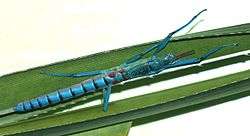Megacrania batesii
Megacrania batesii, commonly known as the peppermint stick insect, is a bluish-green coloured stick insect that only lives on the midribs of the leaves of the "screwpine" Pandanus tectorius. If disturbed during the day, it emits a fine spray of a milky substance with an odor resembling peppermint.[1] They do not use their hind legs for locomotion.[2][3]
| Megacrania batesii | |
|---|---|
 | |
| Scientific classification | |
| Kingdom: | |
| Phylum: | |
| Class: | |
| Order: | |
| Family: | |
| Subfamily: | Platycraninae |
| Genus: | Megacrania |
| Species: | M. batesii |
| Binomial name | |
| Megacrania batesii Kirby, 1896 | |
| Synonyms | |
| |
Taxonomy
This species was first described by William Forsell Kirby in 1896.[4] Another Megacrania species, M. alpheus should possibly be included in M. batesii.[5]
Distribution
The species occurs in Queensland, as well as several islands in the Pacific Ocean, for example the Solomon Islands, Ambon Island, New Guinea, the New Hebrides and the Philippines.[6]
References
- Costa, James T. (2006). The Other Insect Societies. Harvard University Press. p. 141. ISBN 978-0-674-02163-1.
- "Peppermint Stick Insect (Megacrania batesii)". www.ozanimals.com. Retrieved 2019-05-17.
- Miller, Peter (12 February 2003). "Megacrania batesii". home.swiftdsl.com.au. Archived from the original on 6 February 2012. Retrieved 2019-05-17.
- Kirby, W. F. (1896). "On some new or rare Phasmidae in the Collection of the British Museum". Transactions of the Linnean Society of London. 2. 6 (6): 447–475. doi:10.1111/j.1096-3642.1896.tb00546.x – via Biodiversity Heritage Library.
- Hsiung, Chia-Chi; Yang, Jeng-Tze (December 2000). "Systematic Study of Megacrania Species of Australia (Cheleutoptera: Phasmatidea)". Journal of Orthoptera Research (9): 71–75. doi:10.2307/3503636. JSTOR 3503636.
- Cermak, M; Hasenpusch, J W (2000). "Distribution, biology and conservation status of the peppermint stick insect, Megacrania batesii (Kirby) (Phasmatodea: Phasmatidae), in Queensland". Memoirs of the Queensland Museum. 46: 101–106 – via Biodiversity Heritage Library.
This article is issued from Wikipedia. The text is licensed under Creative Commons - Attribution - Sharealike. Additional terms may apply for the media files.